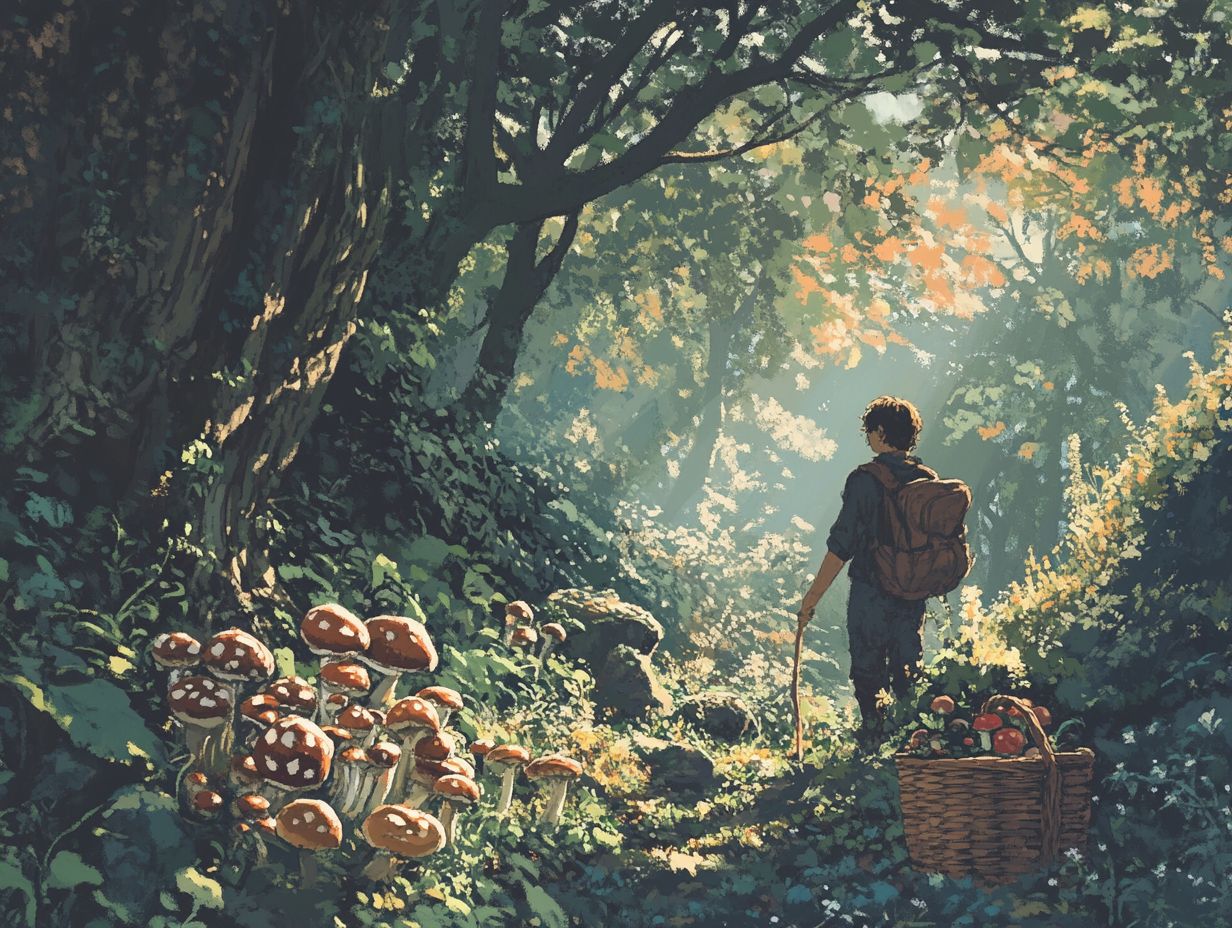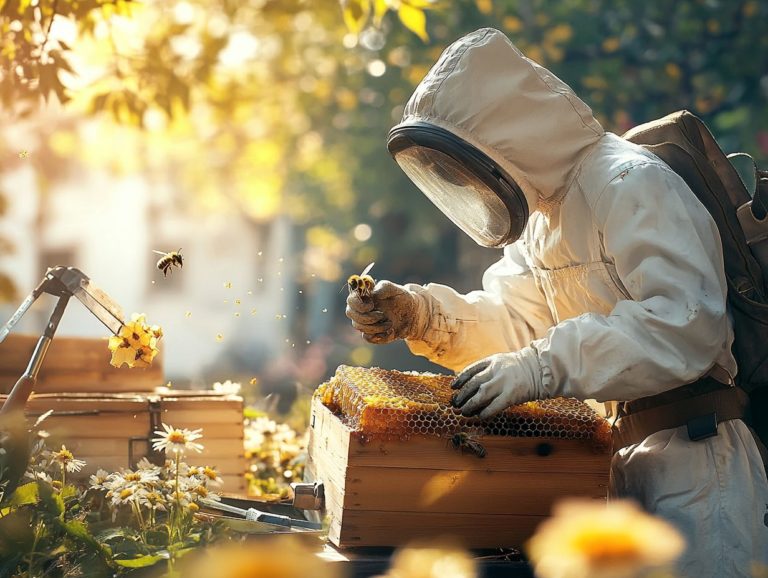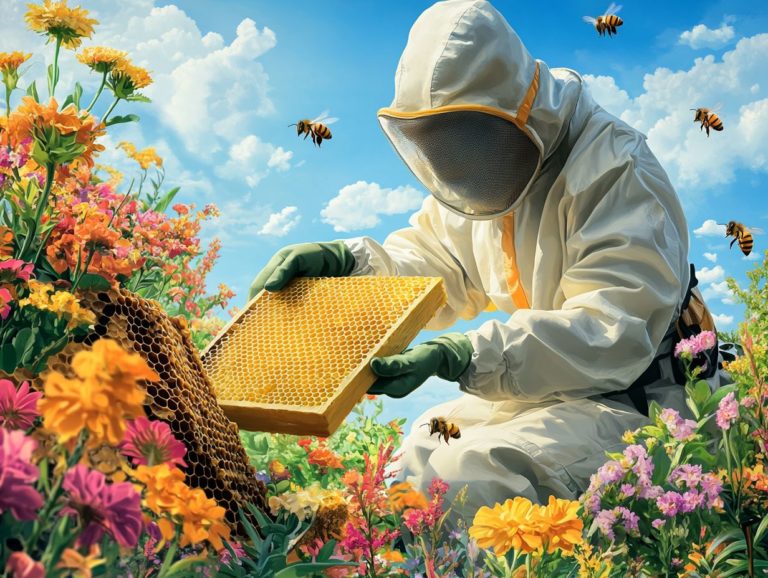How to Manage Natural Foraging
Natural foraging is a rewarding practice that connects you to the wild. It enriches your diet with fresh, nutrient-dense foods and provides immersive nature exploration, offering insights into local ecosystems.
From gathering edible plants and mushrooms to discovering insects and hunting small game, foraging presents a myriad of ways to engage with nature. Sourcing wild plants can also combat invasive species, contributing to a healthier environment.
This article delves into the significance of natural foraging, exploring its diverse forms and the multitude of benefits it offers for your health and the environment. Key practices such as wildcrafting, or gathering plants from the wild, and cooking with plants will be discussed.
You ll find essential tips to help you get started and ensure a safe foraging experience, including guidelines on plant identification and the importance of carrying a first aid kit.
Get ready to dive into the exciting world of foraging!
Contents
- Key Takeaways:
- What is Natural Foraging?
- Why is Natural Foraging Important?
- What Are the Types of Natural Foraging?
- What Are the Benefits of Natural Foraging?
- How to Start Natural Foraging?
- What Are the Safety Precautions for Natural Foraging?
- Frequently Asked Questions
- What is natural foraging and why is it important to manage it?
- What are some benefits of managing natural foraging?
- How can I manage natural foraging on my property?
- Are there any potential challenges to managing natural foraging?
- What are some strategies for managing natural foraging in agricultural areas?
- Managing Natural Foraging
- How can I educate others about the importance of managing natural foraging?
- How can I manage natural foraging on my property?
- Are there any potential challenges to managing natural foraging?
- What are some strategies for managing natural foraging in agricultural areas?
Key Takeaways:

- Natural foraging is the act of gathering wild plants, mushrooms, insects, and animals for food and other uses.
- It promotes sustainable living and connects people to their local environment.
- To start, research local plants and mushrooms, learn identification techniques, and begin with familiar species.
What is Natural Foraging?
Natural foraging is the art of seeking out and gathering edible wild plants, mushrooms, and other natural treasures that nature offers. This timeless practice fosters a deeper connection with the environment while championing sustainable methods that honor local ecosystems.
Foraging requires various skills, including the ability to identify different plants and understand their roles within the ecosystem. This knowledge ensures that you select species that are safe for your palate and advantageous for the environment.
Why is Natural Foraging Important?
Natural foraging is significant as it cultivates a profound connection to the environment, encourages sustainable practices, and promotes the responsible use of local natural resources.
By immersing yourself in foraging activities, you acquire invaluable knowledge about wild plants and their ecological roles. This enhances your understanding of environmental stewardship and deepens your appreciation for biodiversity.
It also opens up the potential to utilize these resources in herbal and medicinal remedies, enriching your relationship with nature in a meaningful way.
What Are the Types of Natural Foraging?
Natural foraging involves a rich tapestry of techniques and practices elegantly divided into four primary categories: plant foraging, mushroom foraging, insect foraging, and animal foraging. Each category demands a unique set of knowledge and skills, including the ability to accurately identify plants and grasp the nuances of seasonal harvesting for various species.
This ensures that you can safely and sustainably gather wild foods while honoring and respecting the delicate balance of the natural environment.
1. Plant Foraging
Plant foraging is an exciting journey into the world of edible wild plants, such as Dandelion, Elderberry, and Oregon grape. Not only are these plants delicious, but they are also packed with nutrients and medicinal benefits. To forage successfully, hone your ability to identify safe species, understand their growth patterns, and recognize the right times for seasonal harvesting all while ensuring sustainability.
To elevate your foraging skills, consider employing various techniques. For example, learning to distinguish between look-alikes and understanding the ecological relationships these plants have with their environments can make a significant difference. Diving into local plant guides and participating in workshops or herbalism courses can greatly enhance your foraging proficiency.
Engaging in foraging also cultivates a deeper appreciation for nature and offers nutritional rewards that often surpass those of cultivated plants. Just remember that sustainable practices are essential. Leaving enough plants for future growth and resisting the urge to over-harvest are key to preserving these wild resources for generations to come.
2. Mushroom Foraging
Mushroom foraging is an exciting adventure full of surprises! It invites you to search for a delightful array of edible wild mushrooms, including the highly sought-after Chanterelles and morels. However, it s essential to ensure proper identification to steer clear of any poisonous varieties.
This captivating pursuit demands a wealth of knowledge about where mushrooms grow, growth cycles, and the environmental impact of your harvesting practices to promote sustainability.
As you embark on this adventurous journey, it s vital to familiarize yourself with the distinguishing features of various mushrooms. Misidentification can lead to serious health risks. Engaging with local foraging groups or turning to reputable field guides can significantly enhance your skills and bolster your confidence.
Remember, mushrooms are crucial players in our ecosystem. They break down organic matter, recycle nutrients back into the soil, and form essential relationships with plants.
In terms of sustainable foraging, the mantra is simple: take only what you need. By spreading out your harvesting efforts, you can help protect mushroom populations and ensure these remarkable fungi continue their vital role in the ecosystem for generations to come.
3. Insect Foraging
Insect foraging, although still an emerging trend, offers you the intriguing opportunity to gather edible insects like crickets and ants. These are increasingly recognized as a sustainable source of protein.
By understanding the ecological implications of harvesting these critters, you can engage in responsible foraging that promotes alternative food sources and reduces dependence on traditional livestock.
Beyond their remarkable nutritional benefits, which include essential amino acids, vitamins, and minerals, edible insects demand considerably fewer resources to produce than conventional meat. This practice tackles food security challenges and plays a vital role in mitigating greenhouse gas emissions and combating land degradation.
Across various cultures, the consumption of insects is celebrated, with many traditional dishes showcasing their unique flavors and textures. This elevates them from mere survival sustenance to delicious foods.
By embracing insect foraging, you can forge a connection to global culinary heritage while adopting a sustainable and responsible approach to food sourcing. This practice also helps tackle issues of biopiracy, which refers to the unauthorized use of traditional knowledge, by respecting traditional knowledge.
4. Animal Foraging
Animal foraging invites you into the intricate world of hunting or gathering wild animals and their by-products. This practice can spark debate, as it demands a profound understanding of local ecosystems, regulations, and sustainable methods.
By adhering to ethical foraging practices, you play a crucial role in ensuring that animal populations thrive and that natural resources are preserved for generations to come.
To navigate this landscape effectively, you must familiarize yourself with the local laws governing wildlife. This knowledge helps you avoid legal complications and protects endangered species.
Taking the time to understand wildlife populations fosters a crucial balance that supports biodiversity. Such awareness encourages you to respect the delicate relationships within ecosystems.
It cultivates a sense of community among fellow foragers. Sharing experiences, discussing ethical guidelines, and engaging in collective learning can help nurture responsible behaviors.
This community-centered approach to foraging ultimately benefits both people and the environment. Participating in group workshops or guided foraging excursions can further enhance your understanding, creating a culture of shared respect for natural resources.
What Are the Benefits of Natural Foraging?

Engaging in natural foraging presents a wealth of benefits that span nutritional, environmental, and financial dimensions. This renders it a worthwhile endeavor for both individuals and communities.
By gathering wild plants, mushrooms, and other natural resources, you gain access to fresh, nutritious foods and potential herbal remedies. This practice enhances your diet and fosters a deeper awareness of environmental issues.
All of this contributes to your personal well-being and that of your community.
1. Nutritional Benefits
The nutritional benefits of natural foraging are remarkable. Wild plants and mushrooms frequently boast higher levels of vitamins, minerals, and antioxidants than their cultivated counterparts. Seasonal harvesting techniques ensure you get the best nutritional value.
Consider the edible wild plants like dandelions and Oregon grapes. They not only elevate your cooking skills but also offer medicinal properties that can function as effective herbal remedies. Plants like rosemary and elderberry are also highly beneficial.
Foraging lets you discover nutrient-rich options like nettles and lamb’s quarters. Nettles are renowned for their impressive iron content, while lamb’s quarters are brimming with vitamins A and C. Incorporating these wild foods into your meals does more than enhance your nutritional intake; it also fosters a sustainable lifestyle, allowing you to connect deeply with your local ecosystem.
Many foraging guides provide safe harvesting techniques and practical uses for these plants, empowering you to explore herbal remedies that have stood the test of time.
Ultimately, adding these wild edible plants to your diet can transform your culinary experience and confer a multitude of health benefits.
2. Environmental Benefits
Engaging in responsible foraging offers you a wealth of environmental benefits, from protecting different species to controlling invasive species. By responsibly harvesting wild plants and mushrooms, you can actively contribute to maintaining healthy ecosystems and ensuring the long-term sustainability of our precious natural resources.
These practices not only help local environments thrive but also cultivate a profound connection between you and the natural world. Foraging heightens your awareness of local flora, empowering you to identify invasive species that jeopardize native habitats. By selectively removing these intruders, you play a significant role in restoring ecological balance, enhancing the chances for native plants to flourish.
Responsible foraging fosters a culture of respect for nature. It encourages you to appreciate the importance of harvesting within limits. This mindful approach nurtures the growth of essential plant populations for future generations. This harmonious interaction enriches your well-being and the ecosystem around you.
3. Cost Savings
You can save a lot of money through natural foraging! This practice grants access to free, nutritious food sources like wild plants and mushrooms. It not only enhances your knowledge but also encourages a culture of learning and sharing within your community, ultimately fostering a sense of resourcefulness.
As you explore local parks, forests, and even your own backyard, you may discover a treasure trove of edible plants that can effortlessly supplement your diet, all while sparing your wallet from the usual grocery shopping strain.
The ability to gather food through foraging eases the pressure on your household budget and deepens your connection to the environment.
When you join forces with others to exchange experiences and wisdom about foraging techniques, you expand your understanding of sustainable practices while forging meaningful bonds within your community. This collaborative spirit can inspire a variety of initiatives, from group foraging excursions to workshops, further enriching your community s knowledge base and promoting a lifestyle centered around self-sufficiency.
How to Start Natural Foraging?
Start your foraging adventure today! Embarking on your journey into natural foraging demands a blend of thorough research, hands-on practice, and a genuine curiosity about the local flora and fauna.
By familiarizing yourself with the edible wild plants in your vicinity, grasping their growth patterns, and honing your plant identification skills, you ll be well-equipped to engage in foraging confidently and responsibly, all while respecting safety and ecological guidelines.
1. Research Local Plants and Mushrooms
Researching local plants and mushrooms is the crucial first step in your foraging journey. This knowledge equips you to confidently identify edible species while steering clear of harmful ones. By using foraging resources like field guides and local workshops, you can significantly enhance your understanding of native flora.
Field guides tailored to your region can provide invaluable insights into the seasonal availability and appearance of various species. Online platforms and mobile apps dedicated to foraging serve as quick references when you re out in the field, making it easier than ever to identify what you find.
Engaging in workshops or classes, often led by experienced foragers, allows you to practice your identification skills in real-world settings. Not only do these hands-on experiences bolster your confidence, but they also foster a deeper appreciation for the bounty that nature has to offer.
2. Learn Proper Identification Techniques
Mastering proper identification techniques is vital for safe foraging, as it gives you the power to differentiate between edible wild plants and their toxic counterparts. By familiarizing yourself with key characteristics such as leaf shape, flower color, and growth habits you can significantly mitigate the risk of consuming harmful species and help keep your foraging safe and exciting.
Using your senses like aroma and texture can offer invaluable insights into plant identification, aiding you in making informed choices. Resources like field guides, mobile apps, and online forums can further enhance your ability to confirm species and explore their potential uses.
It is crucial to adhere to foraging guidelines, such as harvesting sustainably which means taking only what you need and ensuring that plants can continue to thrive and avoiding over-collection. This ensures the ongoing availability of wild plants and mushrooms while safeguarding the ecosystem. By approaching foraging with respect and diligence, you can cultivate a deeper appreciation for nature while reaping the rewards of wild food.
3. Start with Familiar and Easy-to-Identify Plants
When you embark on your foraging journey, it’s wise to start with familiar and easily identifiable wild plants like dandelions and elderberries. This approach will help you build confidence and expand your knowledge. These plants are abundant and offer excellent opportunities to learn safe foraging practices and hone your plant identification skills.
Take dandelions, for example. You ll often spot them in urban gardens and parks. Their leafy greens can be tossed into salads or brewed into a delightful tea, while their vibrant flowers can be transformed into wine or syrup. Then there are elderberries, easily recognized by their clusters of tiny purple fruits. These gems are perfect for making jams or elderberry syrup, which is celebrated for its immune-boosting properties.
As a novice forager, it’s crucial to steer clear of toxic look-alikes, such as poison hemlock, and always verify your finds using reliable guides or apps. Engaging with local foraging groups can significantly enhance your learning experience, ensuring safety while fostering a supportive environment for exploration.
What Are the Safety Precautions for Natural Foraging?

Safety precautions are of utmost importance when you venture into the world of natural foraging. The potential risks associated with consuming toxic plants or mushrooms can lead to serious health consequences.
Therefore, it s essential for you to be proficient in plant identification and always carry a first aid kit. By adhering to best practices for safe foraging, you can minimize risks and ensure that your foraging experience is not only enjoyable but also enriching.
1. Avoid Picking Plants Near Roads or Pollution
One crucial safety precaution for natural foraging is to steer clear of picking plants near roads or polluted areas. These spots can accumulate harmful substances that compromise their safety for consumption. By foraging in clean, unpolluted environments, you can ensure that the wild plants you gather are safe, nutritious, and environmentally sound.
Choosing the right foraging locations protects your health and preserves local ecosystems. Polluted sites often harbor toxins that can diminish plant vitality, leading to reduced nutrient profiles and increased health risks for those who consume them. Invasive contaminants can disrupt the delicate balance of native flora and fauna, further eroding biodiversity.
By practicing safe foraging techniques now, such as regularly checking environmental conditions and being aware of nearby industrial activities, you enhance your contribution to both your health and the ecosystem’s well-being. This thoughtful approach showcases what responsible foraging is all about!
2. Use Protective Gear and Tools
Utilizing appropriate protective gear and tools is crucial for safe foraging. It enables you to explore various environments while minimizing the risks associated with plants and wildlife. Essential items might include gloves, foraging knives, and baskets for gathering wild plants, all designed to ensure that your experience is enjoyable and fulfilling.
In addition to gloves and knives, consider donning durable, long-sleeved clothing to guard against thorny underbrush and pesky insect bites. Sturdy boots with good traction provide support on uneven terrain and protect your feet from sharp objects lurking in the wild. Don t overlook the value of a first aid kit; it s an invaluable companion that prepares you for any unexpected situations that may arise.
By equipping yourself with the right preparation and gear, you significantly enhance the likelihood of a successful and safe foraging adventure. This allows you to fully immerse yourself in the joy of discovery and deepen your connection with nature.
3. Know Poisonous Plants to Avoid
A fundamental aspect of safe foraging lies in your ability to identify which poisonous plants to avoid. Misinformation can pose serious health risks. Familiarizing yourself with toxic species and their distinguishing characteristics is essential for successful plant identification and ensuring safe foraging practices.
You must be particularly vigilant with plants like deadly nightshade or belladonna, which can be easily confused with more benign species due to their attractive purple berries and lush green leaves. The poison hemlock, infamous for its resemblance to wild carrot, can present a fatal threat if ingested.
Understanding the key features of these plants such as their flower structure and habitat preferences is crucial. Taking the time to educate yourself about these poisonous varieties is more important than ever, as even seasoned foragers can inadvertently harvest harmful plants.
By consistently following common foraging rules, you can significantly reduce the likelihood of dangerous mistakes in your foraging adventures.
Frequently Asked Questions
What is natural foraging and why is it important to manage it?
Natural foraging is the process by which animals search for and obtain food in their natural habitat. It is important to manage natural foraging to ensure the sustainability of food sources and the health of the ecosystem.
What are some benefits of managing natural foraging?
Managing natural foraging helps prevent overgrazing and destruction of vegetation, maintains a balanced predator-prey relationship, and promotes the diversity of plant and animal species in an ecosystem.
How can I manage natural foraging on my property?
You can manage natural foraging by creating designated grazing areas, implementing rotational grazing, planting native vegetation, and providing supplemental food sources during times of scarcity.
Are there any potential challenges to managing natural foraging?
Yes, some challenges of managing natural foraging include balancing the needs of different species, dealing with unpredictable weather patterns, and preventing the spread of invasive species.
What are some strategies for managing natural foraging in agricultural areas?
Effective strategies include creating sustainable practices, engaging local communities, and monitoring wildlife populations to ensure a balance between agriculture and natural foraging.
Managing Natural Foraging
In agricultural areas, it is crucial to rotate crops and use cover crops. Creating buffer zones can support natural foraging and protect the soil from erosion and nutrient depletion.
How can I educate others about the importance of managing natural foraging?
Share information and resources to educate others about the benefits of managing natural foraging. You can also organize community workshops or events and set a good example through your own actions and practices.
How can I manage natural foraging on my property?
Take charge of natural foraging with these simple steps! Create designated grazing areas, implement rotational grazing, plant native vegetation, and provide supplemental food sources during times of scarcity.
Are there any potential challenges to managing natural foraging?
Yes, some challenges include balancing the needs of different species, dealing with unpredictable weather patterns, and preventing the spread of invasive species.
What are some strategies for managing natural foraging in agricultural areas?
In agricultural areas, it is important to rotate crops, use cover crops, and create buffer zones to support natural foraging and protect the soil from erosion and nutrient depletion.







